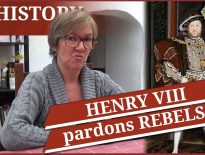On this day in Tudor history, 2nd December 1546, Henry Howard, Earl of Surrey, poet, courtier, soldier and the eldest son of Thomas Howard, 3rd Duke of Norfolk, was arrested after Richard Southwell, his former friend, gave evidence against him.
King Henry VIII had just weeks to live and was increasingly paranoid, so Southwell's 'evidence' was just what Surrey's enemies needed to bring the earl down.
Find out more about the Earl of Surrey's downfall, and how his father managed to keep his head, in today's talk.
Henry Howard, Earl of Surrey, ended up being executed and you can find out more about that in my video from 19th January, see below today's one.
Also on this day in history:
- 1560 – Death of Charles de Marillac, French diplomat and Archbishop of Vienne, at Melun in France. Marillac was a resident ambassador at the court of Henry VIII from 1538 to 1543 and described Henry VIII as having three vices, which he described as “plagues”: “the first is that he is so covetous that all the riches of the world would not satisfy him. Thence proceeds the second, distrust and fear. This King, knowing how many changes he has made, and what tragedies and scandals he has created, would fain keep in favour with everybody, but does not trust a single man, expecting to see them all offended, and he will not cease to dip his hand in blood as long as he doubts his people. The third vice lightness and inconstancy.”
Marillac was banished from the French court in 1560 after opposing the policies put forward by the Guises at the Assembly of Notables at Fontainebleau. - 1586 – Parliament met on the 2nd December following their request for Elizabeth I to sanction the execution of Mary, Queen of Scots, and the commissioners' meeting in the Star Chamber where they condemned her to death. A draft proclamation of sentence, written by Elizabeth and William Cecil, Lord Burghley, was published at the Parliament, and this was followed by the drafting of an execution warrant by Sir Francis Walsingham.
- 1615 – Burial of Edward Wright, mathematician and cartographer, at St Dionis Backchurch, London. He died in late November 1615, while working on his book “A Description of the Admirable Table of Logarithmes”. Wright is known for his work on the mathematics of navigation and his 1599 treatise “Certaine Errors of Navigation”, which explained and developed the Mercator projection.
Transcript:
On this day in Tudor history, 2nd December 1546, Henry Howard, Earl of Surrey, poet, courtier, soldier and the eldest son of Thomas Howard, 3rd Duke of Norfolk, was arrested after Richard Southwell, his former friend, gave evidence against him.
François van der Delft, the imperial ambassador, reported to Emperor Charles V on 14th December that Surrey had been “detained” but that “The reason for this is still unknown”, going on to write of how the gossip was that Surrey and his father, who had also been detained by that point, “held secretly some ambiguous discourse against the King, whilst the latter was ill at Windsor six weeks ago; the object being to obtain the government of the Prince.”
The actual charge against Surrey, however, was improper heraldry. According to Southwell, Surrey had used the arms of his ancestor Edward the Confessor in a shield he’d had painted at his home of Kenninghall, something which only the King was entitled to do, and he had placed the arms of England in the first quarter of his shield, indicating that he had a direct claim to the crown. As Edmond Bapst, Surrey’s 19th century biographer points out, though, this last accusation was false: “Surrey had placed the royal arms in the second quarter, and had been careful to differentiate them by collaring the leopards.”
Historian Lady Antonia Fraser points out that Surrey's real mistake was in having quarrelled with Edward Seymour, Earl of Hertford, who took over Surrey's command in France. Surrey was jealous of Hertford and his achievements, so the improper use of the royal arms “could be construed by his rivals as a deliberate advancement of the superior Howard claims to the regency.”
Whatever the case, Southwell’s information on Surrey was enough for his enemies to use against him and bring him down. The already paranoid Henry VIII, who was now in the last weeks of his life, could easily be made to believe that the Howards had designs on the regency.
In a trial at London’s Guildhall on 13th January 1547, Surrey was found guilty of treason and sentenced to be hanged, drawn and quartered. The sentence was commuted to beheading and he was beheaded on Tower Hill on 19th January 1547. His father, the Duke of Norfolk, was more fortunate. The King died before he was due to be executed and although he was kept in prison for the whole of Edward VI’s reign, he was released in 1553 when Mary I pardoned him.



I used one of his poems for a journaling assignment for an online class I take every year (sort of a growth thing, become a better me thing), and I really like what I’d found and would love to see more. Sad end to a brilliant man. Michelle t
Henry Howard, Earl of Surrey was a bit of a jack the lad but he wasn’t a traitor and he put his arms in the second quarter and had every right to use these arms. His problem was indeed the Seymour rise to power and his family represented the old order so had to go before young Edward came to the throne. His poetry was wonderful and timeless. I used one at my mother in laws funeral. Henry was led to destroy all those he no longer trusted with the future. Howard tried to escape down the loo shaft in his cell in the Tower but was caught. He paid with his life. A great shame.